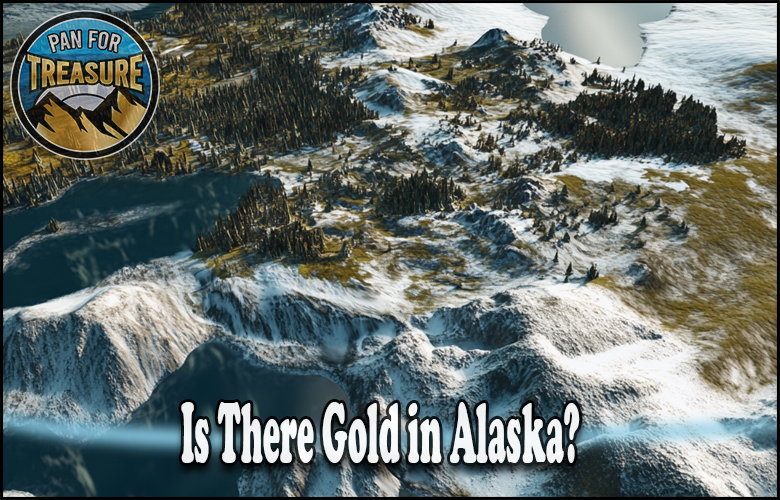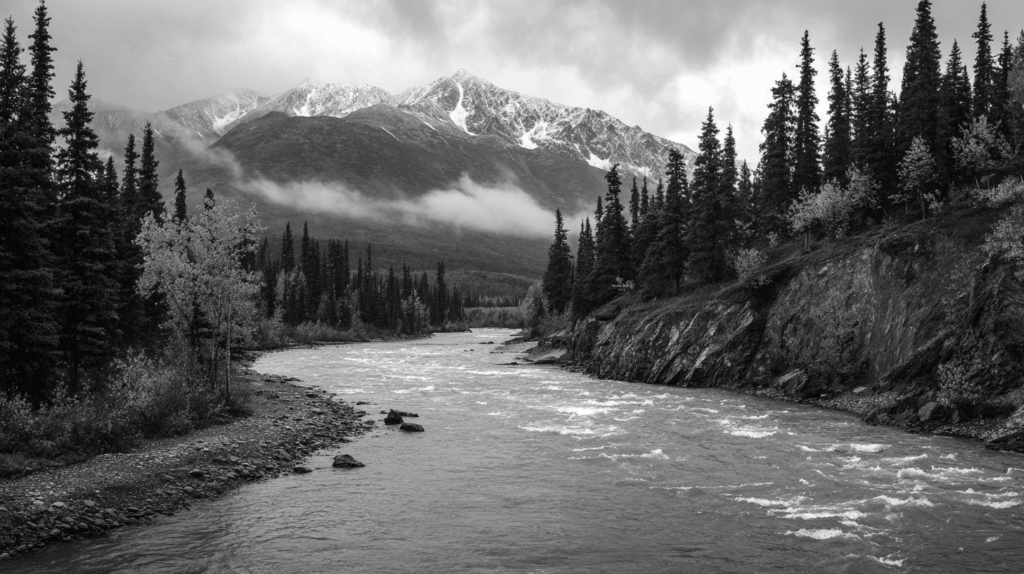
Disclosure: This Post Contains Affiliate Links; We earn a commission on purchases.
Is There Gold in Alaska? – Alaska, known for its rugged beauty and vast wilderness, is also home to a hidden treasure – gold.
Gold mining in Alaska has been a major industry since the United States acquired the territory in 1867.
The state has a rich history of gold mining, with Russian explorers discovering placer gold in the Kenai River in 1848.
Since then, Alaska has seen significant gold production, with areas near Fairbanks, Juneau, and Nome being the main sources.
Alaska currently produces a significant amount of gold, with over 539,390 troy ounces produced in 2019 alone.
The state is home to both large-scale hard-rock mines and small-scale placer gold mining operations.
These mining activities contribute to Alaska’s economy and provide employment opportunities for many.
Key Takeaways:
- Alaska has a rich history of gold mining.
- Areas near Fairbanks, Juneau, and Nome are the main sources of gold in Alaska.
- Alaska produces over 539,390 troy ounces of gold annually.
- There are both large-scale hard-rock mines and small-scale gold mining operations in the state.
- Gold mining in Alaska is an important industry that contributes to the state’s economy.
Is There Gold in Alaska?
Gold is abundant in Alaska and continues to be a significant part of the state’s economy and history.
Gold has been mined throughout Alaska since the late 19th century, following early discoveries by Russian explorers and the subsequent gold rushes that fueled exploration and settlement.
Gold is not only present in Alaska, but it is also actively mined both commercially and recreationally.
The state’s geology, shaped by millions of years of tectonic and erosional processes, has created rich deposits that continue to attract miners and prospectors today.
Where is Gold Found in Alaska
- Gold occurs almost everywhere in Alaska except for the vast swamps of the Yukon Flats and the North Slope between the Brooks Range and the Beaufort Sea.
- Major gold-producing areas include regions near Fairbanks, Juneau, and Nome, which have historically produced most of Alaska’s gold and still account for all current production
Alaska, the Last Frontier, has long been synonymous with gold rush dreams.
From the historic Klondike Gold Rush to modern-day prospecting, the state’s rugged terrain holds the promise of untapped riches.
But is there still gold waiting to be discovered?
Look into the history, geology, and opportunities that make Alaska a gold prospector’s paradise.
Major gold-producing mines in Alaska
Alaska is home to several active gold-producing mines that contribute significantly to the state’s overall gold production.
These mines include:
| Mine | Location | Gold Production in 2019 (troy ounces) |
|---|---|---|
| Fort Knox mine | Fairbanks North Star Borough | 200,263 |
| Pogo gold mine | Goodpaster district | 154,589 |
| Kensington gold mine | North of Juneau | 127,914 |
| Greens Creek mine | Southwest of Juneau | 56,625 |
These mines, along with others scattered throughout Alaska, play a crucial role in maintaining the state’s reputation as a significant gold-producing region.
The Fort Knox mine, located in the Fairbanks North Star Borough, is an open-pit operation that produced 200,263 troy ounces of gold in 2019.
The Pogo gold mine, situated in the Goodpaster district, is an underground mine that yielded 154,589 troy ounces of gold in the same year.
North of Juneau lies the Kensington gold mine, an underground mine that contributed 127,914 troy ounces of gold to Alaska’s total production.
Lastly, the Greens Creek mine, located southwest of Juneau, is a silver-lead-zinc-gold mine that produced 56,625 troy ounces of gold in 2019.
These gold-producing mines showcase the diverse mining methods employed throughout Alaska, including both open-pit and underground operations.
With their consistent production, they demonstrate the region’s vast potential for extracting valuable gold resources.
Advanced gold-bearing hard rock exploration projects in Alaska
In addition to operating mines, Alaska is also home to advanced exploration projects for gold-bearing hard rock deposits. These projects have the potential to significantly contribute to future gold production in the state.
Donlin Gold project
The Donlin Gold project, located in the Kuskokwim Gold Belt, is an impressive undertaking. It is one of the largest known undeveloped gold deposits in the world.
With a proven and probable reserve of 33.8 million ounces of gold, the Donlin Gold project has the potential to become one of the largest gold mines if developed according to plans.
This project has generated significant interest and could play a crucial role in Alaska’s gold mining industry.
Pebble Copper deposit
Discovered in 1987, the Pebble Copper deposit is one of the largest known copper-gold porphyry deposits globally. It contains a measured and indicated resource of 70.6 million ounces of gold, making it a highly significant find.
This deposit’s large-scale potential has attracted attention from investors and mining companies, and its development could contribute significantly to Alaska’s gold production.
Niblack prospect
The Niblack prospect is located on Prince of Wales Island and is a copper-gold-zinc-silver VMS deposit. With an indicated resource estimate of 317,220 troy ounces of gold, the Niblack prospect holds considerable promise.
Exploration efforts in this area have revealed its potential for future gold production, making it a significant project to monitor.
These advanced exploration projects, including the Donlin Gold project, the Pebble Copper deposit, and the Niblack prospect, highlight the vast opportunities and potential for future gold mining ventures in Alaska.
“These projects show the potential for future gold production in Alaska.”
Placer mining in Alaska
Placer mining is a significant part of Alaska’s gold mining industry, involving the extraction of gold from sands and gravels deposited by streams and rivers.
With a long history dating back to the Klondike Gold Rush in the late 1890s, placer mining continues to attract prospectors and gold enthusiasts to Alaska.
Although on a smaller scale compared to the past, placer mining still occurs throughout the state.
During the Klondike Gold Rush, thousands of miners flocked to Alaska in search of their fortune. They used simple tools like pans, shovels, and sluice boxes to separate gold from the surrounding gravel.
Despite the challenges faced by these early pioneers, the allure of striking it rich drew people from all walks of life to the Alaska wilderness.
Today, placer mining remains an active and important part of Alaska’s overall gold production. In the past five years, placer mining has contributed an average of around 74,360 ounces of gold annually.
Although the production may not be as substantial as it once was, it still plays a vital role in the state’s mining landscape.
Placer mining operations in Alaska are often seasonal, with many miners taking advantage of the short summer months when rivers and streams are easier to access.
The small-scale, family-operated nature of placer mining adds to its charm, as it allows individuals to try their luck and potentially discover the hidden treasures of Alaska’s waterways.
“Placer mining has a rich history in Alaska, from the gold rushes of the past to the present-day operations that continue to extract gold from the state’s rivers and streams. It’s a testament to the enduring allure of gold and the adventurous spirit of those who seek it.”
Historical Lode and Placer Gold Mines in Southeast Alaska
Southeast Alaska has a rich history of gold mining, with several districts playing a significant role in the state’s gold production.
Let’s explore some of the key historical mining districts in this region.
Juneau Mining District
The Juneau mining district, which includes the capital city of Juneau, was one of the most prolific gold-producing areas in Southeast Alaska.
This district saw the recovery of over 7 million ounces of lode gold and 80,000 troy ounces of placer gold. The discovery of gold in the Juneau area in the late 1800s sparked a mining boom and laid the foundation for the region’s prosperity.
Admiralty District
The Admiralty district, centered around Admiralty Island, primarily achieved its gold production as a byproduct of silver and base metal mining.
This district has been known for its extensive silver deposits, but it also contributed significantly to Alaska’s overall gold production. Although gold was not the primary focus, it played a vital role in the district’s mining operations.
Porcupine District
The Porcupine district, located near Haines, has a storied history of placer gold mining. Prospectors flocked to the area during the gold rushes in the late 1800s, leading to the extraction of over 81,000 troy ounces of placer gold.
The Porcupine district showcased the potential for profitable placer mining operations in Southeast Alaska.
“The historical mining districts in Southeast Alaska hold a significant place in the state’s gold mining industry. These areas were instrumental in shaping Alaska’s reputation as a gold-rich territory and attracted miners from far and wide.” – Your Name
Despite the passage of time, the legacy of these historical mining districts lives on, reminding us of the rich mining heritage of Southeast Alaska.
| Mining District | Lode Gold (ounces) | Placer Gold (troy ounces) |
|---|---|---|
| Juneau | 7,000,000 | 80,000 |
| Admiralty | – | – |
| Porcupine | – | 81,000 |
The Echoes of Alaska’s Gold Rush History
The Alaska Gold Rush is a tale of ambition, grit, and sheer determination.
Triggered in the late 19th century by a series of transformative gold strikes, this historical chapter drew thousands of gold seekers to the untamed wilderness of the Yukon Territory, the Yukon River basin, and beyond.
Mining camps popped up seemingly overnight as hopeful prospectors navigated harsh landscapes and freezing conditions in pursuit of fortune.
Areas like Gold Creek and the storied Bering Sea became synonymous with opportunity, with placer deposits sparking dreams of untold riches.
Over time, advancements in mining technology, like suction dredges and metal detectors, revolutionized the search for gold, allowing modern miners to explore previously inaccessible mining sites.
Companies such as Kinross Gold Corporation have since solidified Alaska’s reputation as a hub of extensive gold reserves.
Today, Alaska’s gold mining tradition endures, especially during the summer months and holidays like Memorial Day, when prospectors return to the land of the Alaska Gold Rush seeking their own piece of history.

Gold Panning FAQs for Alaska
Is there gold in the rivers of Alaska?
Yes, Alaska is famous for its rich gold deposits found in rivers like the Fortymile River, the Klondike River (near the border), and parts of the Kenai River. These waterways have been the center of gold rushes and remain popular with prospectors today.
Is there gold in Alaska creeks?
Absolutely. Many creeks in Alaska, including Chicken Creek, Crow Creek and Anvil Creek near Nome, have produced significant amounts of placer gold. Even today, small operations and recreational prospectors find gold in these historic creeks.
Is there gold in Alaska’s streams?
Yes, streams across Alaska continue to yield fine gold and nuggets. Seasonal melting and natural erosion replenish gold deposits in streambeds, making Alaska one of the best places in the U.S. for stream panning.
Is there gold today in Alaska?
Gold mining is still active in Alaska. From large-scale commercial operations to recreational panning, prospectors regularly find gold throughout the state. Many public lands allow recreational panning with few restrictions.
Where can I pan for gold in the state of Alaska?
Popular gold panning spots in Alaska include Crow Creek Mine near Girdwood, Gold Dredge 8 in Fairbanks, and public mining areas near Nome. Always review the local regulations, especially if you plan to pan on state or federal land.
{
“@context”: “https://schema.org”,
“@type”: “FAQPage”,
“mainEntity”: [
{
“@type”: “Question”,
“name”: “Is there gold in the rivers of Alaska?”,
“acceptedAnswer”: {
“@type”: “Answer”,
“text”: “Yes. Alaska is famous for rich gold deposits in rivers like the Fortymile River, the Klondike River (near the border), and parts of the Kenai River. These waterways were central to historic gold rushes and remain popular with prospectors today.”
}
},
{
“@type”: “Question”,
“name”: “Is there gold in Alaska creeks?”,
“acceptedAnswer”: {
“@type”: “Answer”,
“text”: “Absolutely. Chicken Creek, Crow Creek, and Anvil Creek near Nome have produced significant placer gold. Small operations and recreational prospectors still find gold in these historic creeks.”
}
},
{
“@type”: “Question”,
“name”: “Is there gold in Alaska’s streams?”,
“acceptedAnswer”: {
“@type”: “Answer”,
“text”: “Yes. Streams across Alaska continue to yield fine gold and nuggets. Seasonal melting and natural erosion replenish streambed deposits, making Alaska one of the best places in the U.S. for stream panning.”
}
},
{
“@type”: “Question”,
“name”: “Is there gold today in Alaska?”,
“acceptedAnswer”: {
“@type”: “Answer”,
“text”: “Yes. Gold mining is still active in Alaska, from large-scale commercial operations to recreational panning. Many public lands allow recreational panning with few restrictions—always check current regulations.”
}
},
{
“@type”: “Question”,
“name”: “Where can I pan for gold in the state of Alaska?”,
“acceptedAnswer”: {
“@type”: “Answer”,
“text”: “Popular spots include Crow Creek Mine near Girdwood, Gold Dredge 8 in Fairbanks, and public mining areas near Nome. Always review state and federal rules before panning.”
}
}
]
}
Conclusion
Alaska is renowned for its rich gold mining history and remains a significant player in the industry. With a long lineage of gold production, the state is home to active mines, advanced exploration projects, and ongoing mining operations.
The presence of major gold-producing mines like Fort Knox, Pogo, Kensington, and Greens Creek, contributes to Alaska’s status as a key gold producer.
These mines yield substantial amounts of gold, further solidifying Alaska’s position in the industry.
Moreover, Alaska is an attractive destination for gold mining enthusiasts and professionals alike.
Its vast mineral resources, comprising significant gold deposits, continue to draw interest and investments from mining companies, explorers, and individuals seeking opportunities.
From the historical mining districts in Southeast Alaska to the promising advanced exploration projects, the state’s golden potential is undeniable.
So, if you’re wondering, “Is there gold in Alaska?”, the answer is resounding – Yes! Alaska remains a land of opportunity for gold mining and exploration.
Source Links
- https://pubs.usgs.gov/fs/1998/0058/report.pdf
- https://alaska.gov/kids/learn/goldpanning.htm
- https://en.wikipedia.org/wiki/Gold_mining_in_Alaska


Meet Ryan Conlon, the passionate owner and driving force behind Pan for Treasure.
With an unwavering love for the art of gold panning, Ryan has transformed his enthusiasm into a thriving community hub for fellow treasure seekers. [email protected]
A seasoned gold panning enthusiast, Ryan’s journey began with a simple pan and a dream, evolving into a deep appreciation for the history, geology, and thrill of uncovering precious metals.
Subscribe to Our Newsletter
